PinotFile: 10.21 November 22, 2015
|
Grapevine Red Blotch Disease: An Emerging and Widespread MenaceAs vintners in California recover from a harried, compact and early 2015 harvest, and concern themselves with the vestiges of a continuing drought, there is apprehension about a new threat. An aggressive virus producing Grapevine Red Blotch Disease (GRBV) is now pervasive in California vineyards of the North Coast, Central Coast and San Joaquin Valley. Reliable field data is lacking, but Cornell researchers reported in 2014 that the virus was widely distributed in vineyards not only in California, but also throughout the United States including the states of Maryland, New York, New Jersey, Oregon, Pennsylvania, Virginia and Washington (*1). Others have reported GRBV in Arizona, Arkansas, Georgia, Idaho, North Carolina and Texas, as well as Canada. GRBV is indiscriminate, infecting many wine grape cultivars including red-berried cultivars Cabernet Sauvignon, Cabernet Franc, Malbec, Merlot, Mourvèdre, Petit Sirah and Petit Verdot, Pinot Noir and white-berried cultivars Chardonnay, Pinot Gris, Riesling, Rousanne, Semillon and Viognier. Infected vines have been found in first leaf as well as mature vineyards. The virus has also been found in table grapes. Agri-Analysis in West Sacramento, California, reported in 2015 the percentage of positive samples in all samples tested over the past three growing seasons (2013-2015). Results from a large number of grapevines from various sources including existing vineyards and new planting material revealed the infection rate of Red Blotch Disease to be between 15% and 25%. Bob Martin, a research plant pathologist for the USDA-ARS Horticulture Crops Research Unit in Corvallis, Oregon, told me, “Red Blotch occurs in Oregon for sure, based on what I have seen and testing we have done. It has been discovered in about 15 to 20 vineyards by early 2014, with only a few vines affected in some vineyards while the signs of infection are pervasive in others. It is moving very slowly in the Willamette Valley and is spreading in southern Oregon, but I am not sure how fast.” The Red Blotch virus is one of some 65 different viruses that have been identified in grapevines (Vitis and Muscadinia) since 1962, but it is different from most other known grapevine infecting viruses in that its genetic material is DNA, rather than RNA. It is a member of a new genus in the geminivirus family, Geminiviridae, that carries the name GRBaV, or “Grapevine Red Blotch-Associated Virus,” to describe its association with the grapevine and red blotch disease. Jim Wolpert, a University of California at Davis-based Cooperative Extension viticulturist and Mike Anderson, a University of California at Davis viticulture researcher, first discovered the disease in 2008 at the University of California at Davis Oakville Station Experimental Vineyard in Napa Valley. Cabernet Sauvignon vines grown on 101-14 rootstock planted there in 2001 showed leaf changes (red blotches along leaf margins and red foliar veins) that resembled those caused by leafroll virus, but the vines tested negative for that virus. The block was found to have GRBaV in 46% of the vines. The GRBaV virus has been present in California vines before this discovery. M. Al Rwahnih, A. Rowhani and D. Golino from the Department of Plant Pathology at University of California at Davis analyzed specimens originally collected by Professor Harold Olmo of the Department of Enology and Viticulture at University of California at Davis between 1937 and 1950 (*2). One sample tested positive for GRBaV as Vitis vinifera cv. (early Burgundy known as Abouriou) collected in Sonoma County in 1940. The leaves showed typical red blotch disease symptoms. This study suggests that GRBaV was present in California vineyards (at least where the specimens were taken) 74 years ago. The exact origin of GRBaV is undetermined. The virus has not been discovered outside North America suggesting it may have originated here. The National Clonal Germplasm Repository (NCGR) in California has found grapevine accessions from countries outside North American including Europe that have tested positive for GRBaV, but this is not proof that the virus occurs in those countries. According to Dr. Judit Monis, Plant Health Services Division Manager of Eurofins STA Laboratories in Gilroy, California, and others, a lack of education, the confusion with Grapevine leafroll-associated virus (GLRaV), nutritional deficiency, late season dormancy, insect feeding damage, environmental stresses, soil conditions, and fungal pathogens have delayed the identification of GRBV in domestic grapevines. The possible emergence of a more virulent strain of GRBaV and the failure to institute practices to curtail it, have led to the spread of GRBV. Researchers indicate that the symptoms of Red Blotch Disease in red-berried grapevine cultivars first appear in June to July in the Northern Hemisphere as irregular blotches on older leaf blades on the basal portions of shoots (*3). The blotches can expand and coalesce across most of the leaf blade and progressively move toward the top of the canopy late in the season (August to October in the Northern Hemisphere). Affected leaves may drop off prematurely. There are variations in reddening depending on the cultivar and rootstock. The changes resemble leafroll disease, but the leaf margins in GRBV do not roll downward, and the leaf veins in GRBV turn partly or fully red while leafroll has green veins. The visual diagnosis of GRBaV-infected vines can be difficult, especially since grapevines often have multiple viruses at the same time, including leafroll virus, that produce other symptoms, making DNA-based assays the only reliable method of accurate diagnosis. Confounding the diagnosis is the determination that vines can test positive for the virus but have no symptoms or symptoms may appear in one vintage and not another. The two photos below show red blotch in a Russian River Valley vineyard taken after harvest in October 2015. The vines tested positive for GRBaV.
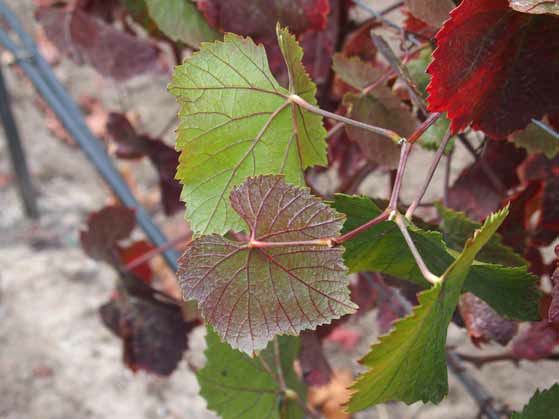
 The two photos below show red blotch signs in Pinot Noir leaves. They are from a report titled, “Red Blotch- Research Status,” by Deborah Fravel of the USDA Agricultural Research Service (*4).
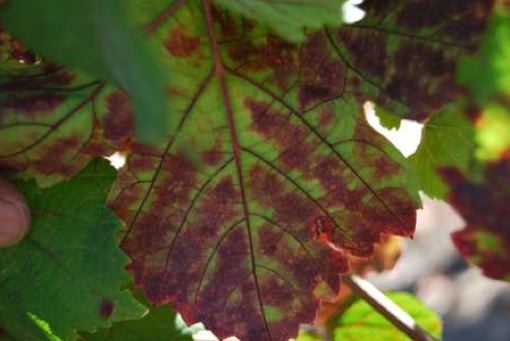
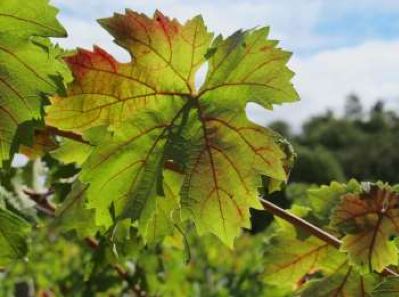 The photo below, also from Fravel’s report, shows the difference in foliar appearance between red blotch and leafroll disease in Cabernet Franc vines.
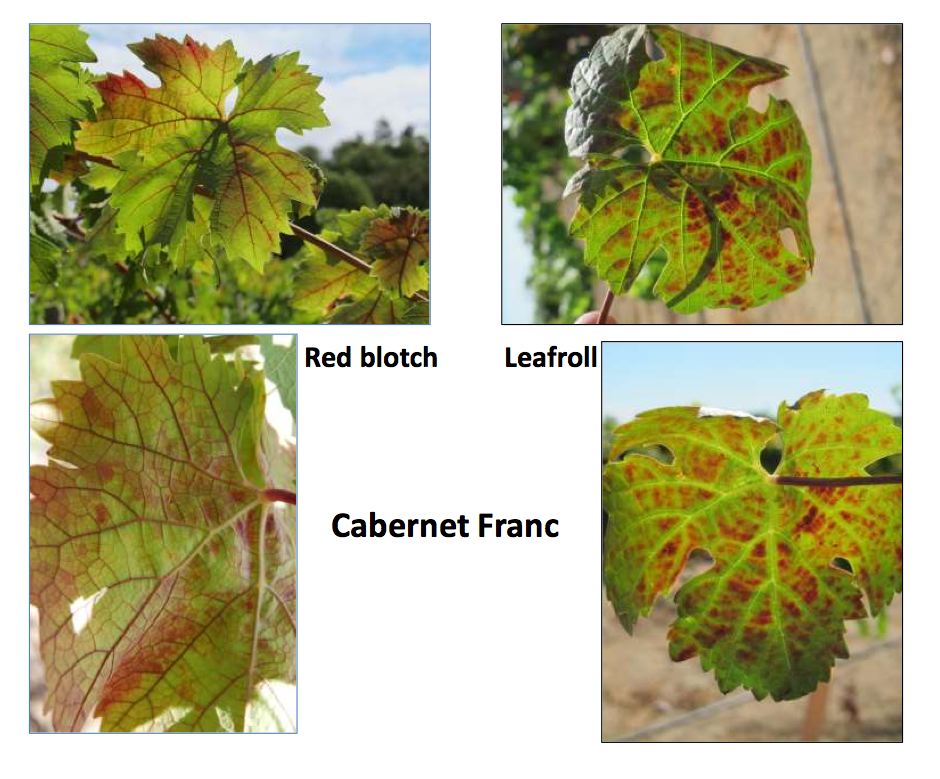 In white-berried cultivars, visual diagnosis is even more challenging. The leaves show irregular, yellow chlorotic areas that can become necrotic later in the growing season. In some cultivars, such as Sauvignon Blanc, the disease may remain asymptomatic. The photo below, also from Fravel’s report, shows Grapevine red blotch virus-associated disease in a Riesling vine.
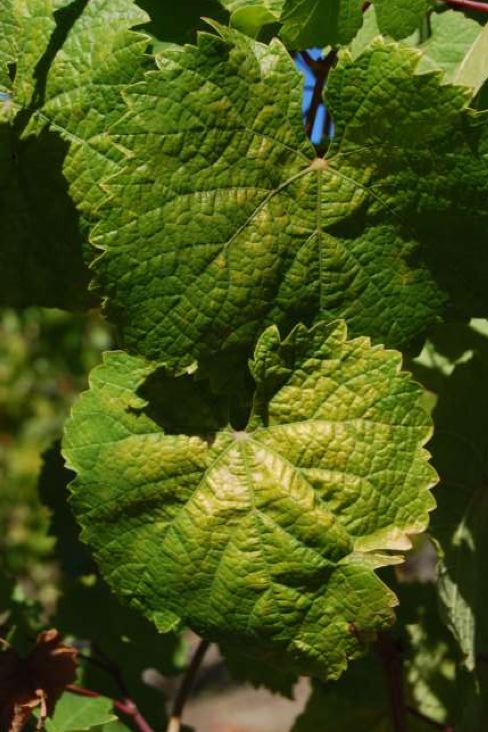 The GRBaV virus was first reported in October 2012 at the 17th Congress of the International Council for the Study of Virus and Virus-Like Disease of the Grapevine (ICVG) held at Davis, California, by researchers at Cornell University and University of California at Davis, who had been working independently and concurrently (*5). Dr. Mysore Sudarshana, a plant pathologist with the USDA Agricultural Research Service at University of California at Davis studied red blotch in vineyards in Napa Valley and worked with Maher Al Rwahnih, a researcher at University of California at Davis Foundation Plant Services (FPS) to test the vines. Using reverse-transcription polymerase chain reaction (PCR) tests, the virus was identified in Cabernet Franc, Cabernet Sauvignon and Zinfandel grapevines that exhibited foliar symptoms of red blotches and red veins accompanied by reduced sugar accumulation in the grapes at harvest. The researchers published the first report of a DNA virus associated with red blotch disease in grapevines in California in 2013 (*6). Cornell researchers found a declining Cabernet Franc vineyard in New York that showed symptoms suggestive of leafroll, but the vines tested negative for all leafroll-associated viruses. The genome of this virus, tentatively named “Grapevine cabernet franc-associated virus” or GCFaV, proved to be identical to the genome discovered by Sudarshana and Rwahnih (*7). It was agreed at the 17th Congress (ICVG) to refer to the virus as “Grapevine red blotch-associated virus” or GRBaV. The relationship between the GRBaV virus and red blotch disease was at first met with resistance absent the completion of Koch’s postulates. This year, Marc Fuchs and colleagues from the School of Integrative Plant Science at Cornell University reported agroinoculation experiments at the 18th ICVG held September 7-11 in Ankara, Turkey, that confirmed the hypothesis that GRBaV was the causal agent of red blotch disease. Fuchs also confirmed that GRBaV was removable through microshoot-tip tissue culture.
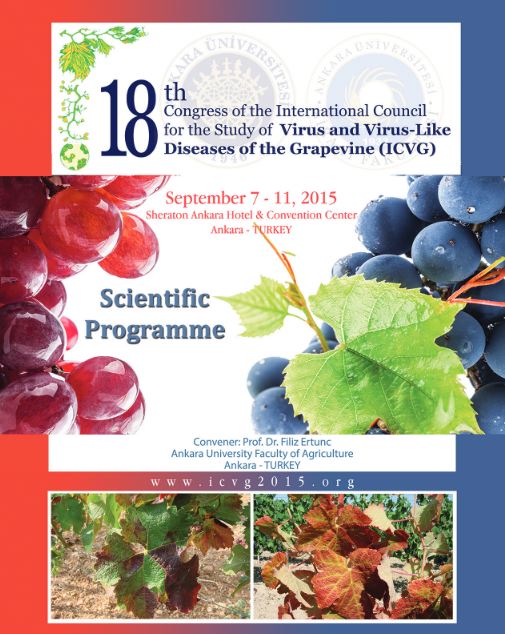 A DNA-based polymerase chain reaction (PCR) assay was developed by Eurofins STA Laboratories soon after GRBaV was reported at the ICVG in 2012. Eurofins HealthCheck Panel RB can detect GRBaV in any tissue of the vine including leaf blades, petioles, clusters, green or dormant canes, cordons and trunks at any time of the season. The virus is discoverable before the onset of symptoms in the affected grapevine. There are two genotypical variants of red blotch. The transmission methods of red blotch disease are not clearly defined although it is certain that grafting and propagation with infected scion and rootstock can spread GRBaV. Growers have been frustrated because they have obtained certified plant material for planting only to later find that GRBaV shows up in their new plantings, since the PCR-based test for GRBaV only became available in October 2012. The existence of a vector has been suggested by an increased incidence of red blotch disease over time in young, healthy vineyards that are adjacent old, infected vineyards, short-distance spread of the virus, clustering of infected vines in some vineyards, and the increase in diseased vines over time (*3). A possible vector, the Virginia creeper leafhopper, has been identified in greenhouse experiments but not in the field. Geminiviridae viruses are known to be transmittable by whiteflies, leafhoppers and treehoppers but every field test over the past three years has failed to find evidence of an insect transmission. University of California at Berkeley entomologist Dr. Kent Daane does not believe there is any conclusive evidence yet that suggests that any of these vectors should be treated with insecticides because of red blotch. There are conflicting reports on spread in vineyards by pruning and harvesting, and some growers have already resorted to sterilizing pruning shears with bleach between each cut as well as sanitizing other mechanical equipment. If such a step in pruning, hedging and harvesting proves to be necessary, the cost of farming grapevines could easily double. Michael Anderson of the Department of Viticulture and Enology at University of California Davis spoke to spread of the virus, saying, “The most important issue concerning red blotch is understanding the mechanism(s) of vine-to-vine spread. It is one thing to do everything you can to ensure clean planting material, but it is quite another to keep it that way.” Bob Martin, a research plant pathologist in Oregon remarked to me about spread in that state. “The virus seems to be clearly spreading in some vineyards. When symptomatic vines are removed, new plants exhibit signs of the disease the following year. There are differing rates of spread depending on whom you talk to, but very little work has been done with tagging vines and looking year after year to monitor spread. We know it’s a problem but we don’t know how severe it is, and we don’t know how to control it.” The effects of GRBD are much more devastating than leafroll. Sugar levels in grapes grown on vines affected by red blotch can suffer a Brix reduction of up to 6º, much more than is seen with leafroll-diseased grapevines. In addition, it has been found that in wines from diseased vines, ripening is delayed, berry weight is reduced, yields are diminished, pH can be reduced, titratable acidity elevated, color reduced in red grapes and wines, and phenolics and tannins disturbed in comparison to wines from non-diseased vines. In essence, once a grapevine is infected and symptoms appear, the grapevine may not produce commercially useful grapes. At the Sonoma County Grape Day event on February 18, 2015, held in Santa Rosa, California, Anita Oberholster of the Department of Viticulture and Enology at University of California at Davis discussed how GRBaV can limit grape development and affect wine made with grapes from virus-positive vines (*9). In extreme cases of red blotch disease, red-berried vines produce pink grapes that never exceed 19º Brix. She reported that in 2014, researches harvested Chardonnay, Merlot and Cabernet Sauvignon grapes from vines that tested positive for GRBaV and from vines that did not. Most of the grapes from vines with red blotch had lower Brix levels ranging from 4% to 20% less, with one Chardonnay sample showing no difference in Brix levels from a virus-positive vine compared to one without the virus. Early on, the bottled wines made with grapes from red blotch-positive vines showed reduced fruit character and more “artificial fruit” flavors. She said, “The wines had a marked difference in taste with virus-positive wines displaying a thinner mouthfeel marked by green and ‘grainier’ tannins.” There are conflicting reports on the effect of GRBaV on the longevity of vines, including some instances of accelerated vine death, but the threat of disease spread within a vineyard and the resultant effects make this nearly irrelevant. There is currently no cure for GRBD and no proven vine management options that can restore normal fruit quality in infected grapevines. Dr. Marc Fuchs of Cornell University recommends that symptomatic vines be tagged in the fall and removed during the dormant season when insect activity is very low or absent. If greater than 25% of a vineyard is diseased, the entire vineyard should be replaced. Some 4 to 10-year-old vineyards in the North Coast have already been removed following recent harvests. It is interesting to speculate that the 3-year drought in California and other climate changes have contributed to the emergence of a more aggressive or at least opportunistic GRBaV virus. The virus appears to hibernate and emerge in cool temperatures and activity may be made active by stress such as drought. Some have suggested that global climate change has driven the virus to migrate from tropical climates to new areas. We know that grapevines as well as all plants have disease resistance mechanisms, some of which are also common in animal and human immune systems, that allow the plant to tolerate certain viruses within and show little disease damage from those pathogens. The interaction of the plant, a pathogen and the environmental conditions is known as the disease triangle. A significant change in the environment, such as drought, can tip the scale in favor of a pathogen and disease damage may appear. Noted winegrower and winemaker Ted Lemon commented to me about disease resistance in grapevines. “There is no doubt that viruses can remain dormant in grapevines for many years. Like humans, I would expect that stress, including drought, could favor expression of the virus. As for the mechanism(s) that induce expression, that is a million dollar question.” Ted elaborated further on virus detection and management in grapevines. “From a viticultural point of view, most of our leading researchers and government agencies take the approach of somehow trying to ‘guarantee’ that plant material will be virus free. They have been singing this siren song for decades. Our plant material has never been virus free. It is clearer than ever that most of the nursery sources and FPS vineyards are full of virus.” Ted advocates more ecological research and less emphasis on cutting-edge virology research. He concludes, “Our goal for people and plants ought not to try to make them virus and disease free, but to create vibrant, healthy ecosystems (be they on the farm or in the home) where balance prevents disease associated with virus expression. In the case of humans, the moral question pushes us to try to insure that no one suffers from virus-induced disease and we err on the side of too much medicine. In the plant world, we can more easily accept the risk that a portion of plants fail if this creates better health in the overall population.” Ted’s words are proven out by a report (Ref National Clean) that indicates GRBaV is widely prevalent in California Department of Food & Agriculture (CDFA)-certified grapevine increase blocks, especially scion blocks. It is also found in CDFA-certified rootstock blocks but at lower frequency than in scion materials. GRBaV is frequently found in non-CDFA-certified scion field selections and clones (*10). The health of foundation stocks and nursery stocks is critical to insure clean vines are planted in the future. The new Grapevine Foundation Block at Russell Ranch at UC Davis FPS was tested in 2013 and is completely free of GRBaV. This vineyard will become the primary source of wood for certified nurseries in the future. A low incidence of GRBaV (less than 1%) has been discovered at the FPS Classic Foundation Vineyard. Nurseries are investing in establishing new increase blocks distant from existing blocks and other vineyards to hopefully provide clean rootstock and scion cuttings for future vineyard plantings. Current vineyard management options for GRBV include the following (*10). (1) Only plant healthy certified grapevine material that has been screened for viruses and certified free of GRBaV by micro-shoot tip culture, either from Russell Ranch at FPS in California or Clean Plant Center Northwest (Washington State University, Prosser, WA). (2) Growers should consider independent lab testing of all orders from nurseries before accepting delivery since the CDFA nursery certification program currently has inadequate protocols for dealing with red blotch disease. When growers who buy CDFA-certified stock, they cannot assume they are buying clean materials. (3) Tag affected vines to allow for future management as more information is available. Remove individual contaminated vines when symptoms become apparent. (4) Do not propagate from any vines, even asymptomatic ones, in an existing vineyard unless individual vines have been tested for known viruses. California winegrape growers with losses due to GRBaV are now eligible for financial assistance for vine replacement from the U.S. Department of Agriculture’s (USDA) Tree Assistance Program (TAP). The program will be in place at least until 2018. There are 30 local USDA Farm Service Agency (FSA) offices in California where USDA Form AD-1026 may be filed to receive TAP funds. For complete details, visit www.cawg.org/ docuserfiles/files/July%202015%20Crush.pdf. No similar program is currently in effect in Oregon, but in late 2014, a group of growers, nursery operators, Oregon Watershed Restoration Inventory (OWRI) faculty, and Oregon Department of Agriculture (ODA) plant health scientists convened to share information, provide an over view of the grapevine virus situation in Oregon vineyards, and plan research into management. ODA plant pathologists together with the Oregon Wine Board planned to apply for an ODA specialty crop block grant to do a survey of red blotch in Oregon vineyards. The group will meet again in December 2015 (*11). 95% of Oregon grapevine nursery stock comes from California, so potentially infected plants may have arrived before testing for GRBaV.
Citations (*1) Krenz, B., et al., “Grapevine red blotch-associated virus Is Widespread in the United States,” Phytopathology, 104:11, November 2014, pp.1232-1240: www.dx.doi.org/10.1094/PHYTO-02-14-0053-R. (*2) Al Rwahnih, M., A. Rowhani, and D. A. Golino, “First Report of Grapevine red blotch-associated virus in Archival Grapevine Material From Sonoma County, California,” Plant Disease, 99:6, June 2015, p 894: www.dx.doi.org/10.1094/PDIS-12-14-1252-PDN. (*3) Sudarshana, M.R., et al., “Grapevine Red Blotch-Associated Virus, an Emerging Threat to the Grapevine Industry,” Phytopathology, 105:7, July 2015, pp. 1036-1042: www.dx.doi.org/10.1094/PHYTO-12-14-0369-FI (*4) Fravel, D., “Red Blotch Research Status,” USDA Agricultural Research Service: www.ngwi.org/files/documents/Presentations_May2014/D_Fravel_52214.pdf. (*5) Al Rwahnih, M., et al., “Virus in grapevines affected by red blotch disease in California,” in Proceedings of the 17th Congress of the International Council of the Study of Virus and Virus-like Disease of the Grapevine (ICVG), Davis, California, October 2012: www.ucanr.edu/sites/ICVG/Documents_to_share/. (*6) Al Rwahnih, M., et al,”Association of a DNA Virus with Grapevines Affected by Red Blotch Disease in California,” Phytopathology, 103:10, October 2013, pp. 1069-1076: www.dx.doi.org/10.1094/PHYTO-10-12-0253-R. (*7) Krenz, B., et al., “Complete genome sequence of a new circular DNA virus from grapevine,” Journal of Virology, 86:14, July 2012, www.jvi.asm.org/content/86/14/7715.full. (*8) Poojari, S., et al., “A Leafhopper-Transmissible DNA Virus with Novel Evolutionary Lineage in the Family Geminiviridae Implicated in Grapevine Redleaf Disease by Next-Generation Sequencing,” PLOS One,June 2013: www.paperity.org/p/60813881/a-leafhopper-transmissible-dna-virus-with-novel-evolutionarylineage- in-the-family. (*9) Adams, A., “Study to Assess Effect of Red Blotch on Wine Quality,” Wines & Vines, April 2015, p. 20. (*10) Stamp, James A., Ph.D., and Alan Wei, Ph.D.,”Red Blotch Disease and the Virus Status of CDFA-certified Grapevine Stock,” Wine Business Monthly, August 2014: www.winebusiness.com/wbm/?go=getArticleSignIn&dataId=136121. See also www.lodigrowers.com/red-blotch-disease-and-the-virusstatus-of-cdfa-certified-grapevine-stock-2/. (*11) Grapevine Red Blotch Disease Oregon Update: www.blogs.oregonstate.edu/owri/2015/01/23/grapevine-redblotch- disease-oregon-update/. More Reading University of California Integrated Viticulture site: www.iv.ucdavis.edu/viticultural_information. National Clean Plant Network Red Blotch Fact Sheet: www.cemendocino.ucanr.edu/files/165430.pdf.
Pinot Noir’s Love-Hate Relationship With Oak
Molly Battenhouse, Wine & Spirits
That said, the marriage of Pinot Noir and oak is a delicate and contentious relationship. Oak aging is as likely to bring a Pinot Noir down than to elevate it. It is an interaction that challenges the winemaker’s touch. Oak’s role as a seasoning for wine is similar to the role salt plays as a seasoning for food. A seasoning is defined as a substance used to add flavor to food primarily for the savor that it imparts. Chefs know that salt enhances food flavors, yet they don’t want food to taste salty. Similarly, winemakers ideally employ oak seasoning to elevate Pinot Noir without imposing the taste of oak in the wine. Dr. Anita Oberhoster, UC Davis enologist, said, “New oak is like garlic or chili in cooking; if you use too much of it you will kill the flavor.”
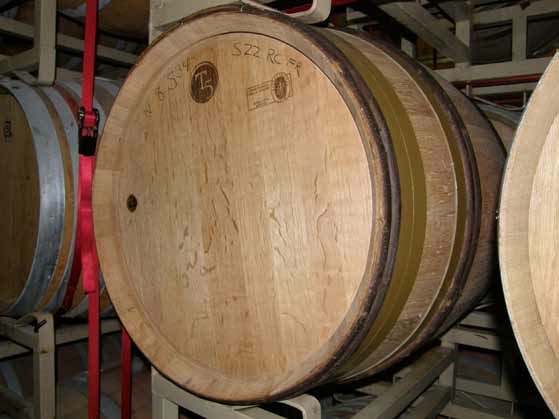 Pinot Noirs that display significant oak aromas and flavors are out of balance and will remain that way. Noted Littorai winemaker Ted Lemon told me, “In my general experience, if a wine tastes too oaky when young then it probably will when it is older. It has to be an incredibly powerful wine to reabsorb that oak. If the wine can take plenty of new oak, and the winemaker has used the right amount, then you probably won’t notice much oak anyway.” Oak should strike a harmonious chord and not be used to rescue a poor wine. Quoting Dr. Oberhoster again, “You cannot turn an ordinary wine into an expensive wine by just exposing it to oak.” Barrel aging Pinot Noir in French oak barrels adds literally hundreds of aromatic and flavor compounds to the wine. The most commonly observed are lactones (coconut, spice and herbaceousness), vanillin (vanilla), guaiacol (char-like smoky aroma and spice), eugenol (clove, nutmeg and cinnamon), furfural (butterscotch, caramel and almond), ellagitannins (astringent taste), and sotolone (maple syrup, caramel, toasted nuts and soy sauce). The combination of more than one of these can produce very complex aroma and flavor perceptions including ash, mushroom, leather, dill, mown hay, grass, tobacco, cedar, sawdust, pine, tar, resin, bourbon, cotton candy, molasses, honey, toffee, marshmallow, butter, popcorn, baked bread, cookie dough, peanut butter, graham cracker, coffee, mocha, barbecue, charcoal, bacon, sweet smoke, burnt sugar, licorice and anise. I find that oak, particularly new oak, can be overbearing in Pinot Noir, and as a result, oak is the first or most prominent aromatic or flavor feature met with when tasting a Pinot Noir wine. Because aggressive oak is not a desirable quality in premium Pinot Noir, I downgrade the wine, but some reviewers do not. Everyone’s tolerance for oak varies and this accounts for the disparity among reviewers’ attitudes toward oak enhancement of Pinot Noir. In a recent issue of the Wine Spectator, I came across these reviews of California Pinot Noir. The wines were highly rated, but the heavy oak overlay described in these wines was a turnoff for me. The 2013 Ferren Silver Eagle Vineyard Sonoma Coast Pinot Noir (94) was described as follows, “Presents a graceful mix of smoky, toasty oak, with touches of charcoal and vanilla bean, wrapped around a tight mix of raspberry, black cherry and wild berry.” The 2012 Olet’te English Hill Vineyard Sonoma Coast Pinot Noir (92) review noted, “Features a strong charry oak presence that dominates for now, yet the intense core of black cherry, wild berry and raspberry fruit rises to the occasion.” There are pinotphiles who relish lavishly oaked Pinot Noir but I am not one of them. I do not want to think of “oak” when tasting Pinot Noir. You have been forewarned, but I will try to describe the oak treatment of wines in an unbiased tenor so the reader can decide if the wine is to their taste.
Scherrer WineryWinemaker extraordinaire Fred Scherrer’s passion for winemaking supersedes his need for notoriety. He produced wines for many years before modernizing his label that puts his name front and center and creating a website that does his wines justice. Still, be assured, Fred will not let it go to his head. His winery has minimal signage and is housed in an undistinguished metal building in an area of Sebastopol in the Russian River Valley where the neighbors prefer that his winery remain inauspicious. Fred is a University of California at Davis graduate who went on to be the winemaker at Dehlinger Winery for ten years before striking out on his own. He has quietly built a stellar reputation among other Sonoma County winemakers as well as consumers who treasure his Pinot Noir, Chardonnay, Cabernet Sauvignon, Zinfandel and other varietals.
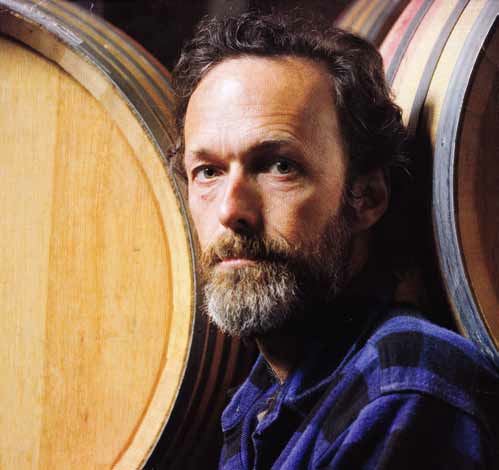 It has been a couple of years since I visited Fred and reviewed his wines. When I sampled how good some of his recent Pinot Noir and Chardonnay releases were, I quickly realized I had stayed away too long. Scherrer Winery does not have a tasting room but does accept some tasting appointments as the wine making schedule allows. Open Houses are held in April, August and mid-November. Fred’s spouse, Judi, handles the business and sales side of the operation and both Fred and Judi’s email addresses are on the website. A newsletter is sent out periodically. Most of the Scherrer wines are sold to the faithful through a mailing list. Visit www.scherrerwinery.com. Fred does not rush to market his wines to satisfy a demand, but does offer wines to consumers ahead of commercial release, knowing that his customers will cellar the wines according to their own tastes. This allows him to survive the financial challenge of holding back vintages until they really shine. That said, Fred does retain a proportion of all his wines to study their development over time. Once a year in November, a few wines from the library are made available. Pinot Noirs are typically de-stemmed, but not crushed. They are barreled very shortly after fermentation in open-top fermenters and pressing, and rested on their lees for 6-10 months before being racked and blended. Total aging in barrel is 16 to 18 months. The wines are bottled unfiltered. Chardonnays are whole cluster pressed, 100% barrel fermentation and malolactic fermentation, nearly 12 months of barrel aging, and bottled unfiltered.
2012 Scherrer Russian River Valley Pinot Noir 14.5% alc., $48. Released October 2015. Unfined and unfiltered. · Moderate reddish purple color in the glass. Aromas of black cherry, spice and a hint of tar lead to tasty, mid weight flavors of black cherry, purple berries, spice and a touch of herbs and red hard candy. Layers of goodness with balanced, slightly gravely tannins, and a succulent finish. Notably complex for an appellation wine. Score: 90
2011 Scherrer Hallberg Vineyard Green Valley of Russian River Valley Pinot Noir 14.5% alc.,48 cases, $75. Released October 2015. Fruit from this vineyard is the normal backbone of the Russian River Valley bottling. · Moderately dark reddish purple color in the glass. A haunting wine, with intense mid weight plus flavors of black cherry, blackberry, cola, spice, dried herbs and a hint of tarry oak. An underlying citric edge brings the juicy fruit alive. Impressive length on the palate and the lush finish. Score: 92
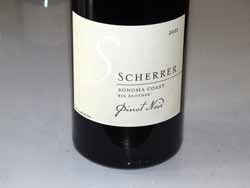 2011 Scherrer ‘Big Brother’ Sonoma Coast Pinot Noir 14.5% alc., 140 cases, $55. Released July 2015. A blend of fruit from a vineyard in Annapolis and one in Bodega. · Moderate reddish purple color in the glass. Charming aromas of cherry, rose, and sous-bois. Intensely flavored yet has the comportment of a ballerina on the palate, with luscious flavors of perfectly ripened dark red cherries and berries wrapped in suave tannins. Impeccably balanced with a charge of cherry extract on the persistent finish. Perfect to drink now, but this wine has the structure and harmony to age beautifully. I recently (mid-2015) consumed a 2007 vintage ‘Big Brother’ and it still had many years of life ahead. Score: 94
2012 Scherrer Helfer Vineyard Russian River Valley Chardonnay 14.5% alc., 117 cases, $48. Released November 2014. This densely planted vineyard is located in the Vine Hill area. Unfined and unfiltered. · Moderate golden yellow color in the glass. Clean and fresh, with inviting aromas of lemon curd, nectarine and buttery brioche. Vibrant, complex and flavorful, featuring tastes of lemon, yellow peach, apple, caramel, toast and spice. A quintessential Russian River Valley Chardonnay that offers plenty of fruit goodness, but is not overblown or weighty. Score: 93
 2013 Scherrer Helfer Vineyard Russian River Valley Chardonnay 14.5% alc., 160 cases, $48. · Moderate golden yellow hue in the glass. Lovely scent of peach, pear, lemon drop, buttery brioche, vanilla and floral bouquet. Bright and lush flavors of lemon, peach, and complimentary oak, with a welcome cut of acidity adding vibrancy and producing a palate cleansing, citrus-fueled finish. Similar to the 2012 vintage, but with a slightly better marriage of fruit and oak, and more riveting fruit flavors. Score: 94
Sips of Recently Tasted Pinot Noir
Alma FriaThe Holtermann family has imported and represented many notable and leading wineries worldwide for three generations. Their personal relationship with the enologists, viticulturists and marketers of these wineries provided a unique lens through which the Holtermanns were able to gain insights into the challenges and intricacies of winegrowing. The Holtermann family planted their roots in the remote ridge tops of Annapolis in the Sonoma Coast and are now committed to handcrafting Pinot Noir and Chardonnay of elegance and complexity. Alma Fria wines are available through allocation: www.almafria.com.
2013 Alma Fria Plural Sonoma Coast Pinot Noir 13.1% alc., 340 cases, $40. Native yeast fermentation, aged 14 months in French oak barrels, 10% new. · Moderate reddish purple hue in the glass Whole cluster character dominates the aromatics which offer scents of bark, spice and red rose petal. Less whole cluster driven on the palate, featuring mid weight flavors of well-spiced cherry and boysenberry with a slight stem note in the background. Good roundness, smoothly textured and admirable harmony with gripping acidity a dominant feature. Score: 88
2013 Alma Fria Holtermann Vineyard Sonoma Coast Pinot Noir 12.9% alc., 138 cases, $58. Vineyard planted in 2002 in Annapolis at 700 to 800 feet elevation. 10% whole cluster. Native yeast fermentation, aged 14 months in French oak barrels, 20% new. · Moderate reddish purple color in the glass. The nose is generous upon opening, offering hi-tone aromas of cherry, rose petal and exotic spices. Acidity drives the light to mid weight core of spiced cherry, cranberry and purple berry fruits that are framed by caressing tannins. The finish is fueled with a charge of fruit, leaving a citrus note in its wake. Still solid the next net day from a previously opened and re-corked bottle. Score: 90
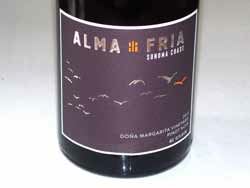 2013 Alma Fria Doña Margarita Vineyard Sonoma Coast Pinot Noir 13.2% alc., 143 cases, $58. Vineyard planted in 2002 in Freestone at 500 to 625 feet elevation. 10% whole cluster. Native yeast fermentation, aged 14 months in French oak barrels, 25% new. · Moderately dark reddish purple hue in the glass. The nose is alive with aromas of black cherry, rose petal and woodshed. Imposing flavors of dark cherry, purple grape and berry, and vivid spice grab on to the palate and finish with an intense flourish. Fine-grain tannins add an appealing touch to the texture. A classy wine. Score: 92
COBB Wines
2012 COBB Coastlands Vineyard 1906 Block Sonoma Coast Pinot Noir 13.6% alc., 200 cases, $80. Sourced from the 14-acre Coastlands Vineyard located near Occidental. This bottling includes a variety of Pinot Noir selections planted on the steepest hillside of the vineyard in 1998 including Pommard and Mt. Eden. “1906” was carved into an old oak tree by the original sheep rancher who worked the land after the great San Francisco earthquake. Aged 30 months in French oak barrels, 35% new. · Moderate reddish purple hue in the glass. The nose offers scents of sweet smoke, char and pine with very demure cherry aroma. Mid weight oakkissed and spiced black cherry, blueberry and pomegranate fruits framed by silky tannins and bright acidity. The noticeably intense herb and cherry driven finish lasts and lasts. When re-tasted the following day from a previously opened and re-corked bottle, the wine still had a significant oak overlay. Score: 88
2013 COBB Rice-Spivak Vineyard Sonoma Coast Pinot Noir 12.5% alc., 450 cases, $70. From a 6-acre vineyard near Sebastopol. Dijon clones and Swan selection planted in Goldridge sandy loam. Aged 22 months in French oak barrels, 35% new. · Moderately light cherry red color in the glass. A classy, feminine wine offering aromas of red cherry pie glaze, rose petal, spice and a woodsy compliment. Silky and delicate on the palate, with flavors of red cherry, strawberry, cranberry and piquant spice notes typical of this vineyard. Very elegant, with suave tannins, a deft touch of oak, tart acidity, and a lovely finish filled with cherry, spice and sandalwood goodness. Score: 92
Dutton-Goldfield
2013 Dutton Goldfield Azaya Ranch Vineyard Marin County Pinot Noir 13.5% alc., pH 3.63, TA 0.58, 279 cases, $58. This vineyard was planted by Mark Pasternak for the McEvoy family in Hicks Valley. There are 5 clones on this 18-acre ranch including 667, “828,” 115, 777 and 2A (only the first three listed are in this wine). 100% de-stemmed, 7-day cold soak, aged 11 months in French oak barrels, 50% new. · Moderately dark reddish purple color in the glass. The nose is reluctant, but does offer pleasing aromas of black raspberry, blackberry and pine with coaxing. Open and forward on entry, with a mid weight charge of purple and black berry, and purple grape flavors, touched with a hint of spice. Modest tannins make for a smooth mouthfeel, and the finish offers impressive length and power. Score: 91
2013 Dutton Goldfield Devil’s Gulch Vineyard Marin County Pinot Noir 13.8% alc., pH 3.65, TA 0.58, 347 cases, $68. This pioneering planting in Marin County is owned and farmed by Mark Pasternak who is dedicated to sustainable agricultural practices. Dijon clones. 100% de-stemmed, 5-day cold soak, aged 17 months in French oak barrels, 50% new. · Moderate reddish purple color in the glass. Highly aromatic, with scents of black raspberry, sous-bois, spice, vanilla and cigar box. This one will put a smile on your face, with a delectable core of fresh dark berry and plum flavors accented nicely with a bit of oak seasoning. Harmonious, soft tannins and a velvety texture complete the picture. Tempting to finish the bottle. Score: 92
13.9% alc., pH 3.61, TA 0.59, 682 cases, $62. This vineyard was planted by Steve Dutton to several Pinot Noir clones. Pommard, 2A, “828,” and 667 were chose for this bottling. 100% de-stemmed, 5-day cold soak, clones fermented separately, aged 17 months in French oak barrels, 55% new. · Moderate reddish purple color in the glass. The nose wants for fruit, offering instead scents of dusty rose and nutty oak. More expressive on the palate, with a generous attack of black cherry and dark berry fruits. Suave and balanced, with modest tannins and a fruit-driven finish that elevates the experience and offers welcome length. Score: 90
2013 Dutton Goldfield Fox Den Vineyard Green Valley of Russian River Valley Pinot Noir 13.8% alc., pH 3.56, TA 0.58, 576 cases, $58. This 8-acre vineyard just above the town of Occidental is planted in Goldridge sandy loam soil to Dijon clones 667, 777 and 115. This wine has equal lots of clone 667 and 777. 100% destemmed, 5-day cold soak, aged 17 months in French oak barrels, 55% new. · Moderately light reddish purple color in the glass. Aromas of berries, musk and earthy flora find traction over time in the glass. Mid weight flavors of woodsy raspberry and cherry are framed by silky tannins. The finish is a bit abbreviated. I wish the wine had slightly less oak overlay. Score: 89
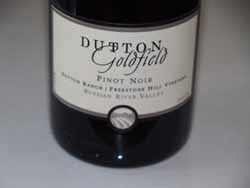 2013 Dutton Goldfield Dutton Ranch Freestone Hill Vineyard Russian River Valley Pinot Noir 13.9% alc., pH 3.65, TA 0.57, 478 cases, $72. This vineyard is located in the extreme southwestern corner of the Russian River Valley appellation on the coastal side of the Petaluma gap and was planted in 1996 (115, 2A and 114) and 1997 (667). 100% de-stemmed, 5-day cold soak, aged 17 months in French oak barrels, 55% new. · Moderate reddish purple color in the glass. The nose is exhilarating, with generous aromas of black raspberry, black cherry and baking spices which elevate over time in the glass. The sappy black raspberry and blackberry fruits have a majestic presence on the palate with the luscious flavors expanding in the mouth and persisting through a lengthy finish. The silky texture contributes to the seductive vibe. Score: 92
2013 Dutton Goldfield Angel Camp Vineyard Anderson Valley Pinot Noir 13.5% alc., pH 3.63, TA 0.58, 459 cases, $58. Sourced from a 11.5-acre vineyard west of Philo. Clones are Pommard, “828,” and 667. 100% de-stemmed, 5-day cold soak, co-fermentation of clones, aged 11 months in French oak barrels, 50% new. · Moderate reddish purple color in the glass. The nose and palate are dark fruited with complimentary notes of oak-driven spice and sandalwood. More Pinot perfume needed. The tannins are well-matched, there is a good acid backbone, and the wine picks up some interest over time in the glass. Still it remains a very good but not special wine. Score: 89
2013 Dutton Goldfield McDougall Vineyard Fort Ross-Seaview Sonoma Coast Pinot Noir 13.8% alc., pH 3.63, TA 0.54, 415 cases, $58. This 9-acre vineyard was planted in 1998 to Dijon clones of Pinot Noir. 100% de-stemmed, 7-day cold soak, aged 14 months in French oak barrels, 50% new. · Moderate reddish purple color in the glass. The aromatic goodness builds over time in the glass, offering scents of raspberry, bourbon, iron and vanilla. Lighter in weight, with a silky, elegant presence on the palate, picking up more pretentious flavor and verve over time. Enjoyable, but doesn’t have the fruit sap that some may prefer. Score: 89
Ken Brown
2013 Ken Brown Santa Barbara County Pinot Noir 14.2% alc., pH 3.71, TA 0.59, 787 cases, $35. A blend of grapes from multiple vineyards in Santa Barbara County with nearly half from Rio Vista Vineyard. 100% de-stemmed, pre-fermentation cold soak, aged 11 months in French oak barrels, 30% new. · Moderately light reddish purple color in the glass. Promiscuous aromas of dark, earthy cherry, red licorice, spice and a hint of smoke are the best feature of this wine. A light to mid weight offering that has enough earthy cherry flavor to satisfy, although the mid palate wants for more intensity. Forward drinking, with modest tannins, a compliment of oak, and a cherry-fueled finish that is not particularly long, but flavorful. Score: 89
2013 Ken Brown Sta. Rita Hills Pinot Noir 14.3% alc., pH 3.68, TA 0.61, 416 cases, $45. 36% Radian Vineyard, 32% Rio Vista Vineyard, 21% Buona Terra Vineyard, and 11% Rita’s Crown Vineyard. 100% destemmed, pre-fermentation cold soak, aged 11 months in French oak barrels, 32% new. · Moderate reddish purple color in the glass. The nose reminds of walking in a recently cultivated field with aromas of earth and mushroom, and a bit of dark cherry and black raspberry. A step up in fruit intensity from the Santa Barbara County bottling, featuring flavors of purple and black fruits and a hint of iron. There is deft oak treatment, the tannins and acidity are well proportioned, and the juicy finish really satisfies. A well composed appellation wine. Score: 90
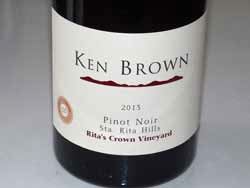 2013 Ken Brown Rita’s Crown Sta. Rita Hills Pinot Noir 14.7% alc., pH 3.51, TA 0.56, 323 cases, $60. This is one of the highest elevation vineyards in the region at 600 to 950 feet. The soils are shallow and the vines are exposed to coastal fog and ocean winds. Planted in 2007, it has quickly become one of the most highly regarded vineyards in the Sta. Rita Hills AVA. Clones 667, 777 and “828.” · Moderate reddish purple color in the glass. Soaring perfume with an array of dark fruits including black cherry and black raspberry, with a hint of spice and rose petal. Flat-out delicious mid weight plus core of black raspberry and blackberry fruit flavors matched to balanced tannins and juicy acidity. The mid palate attack is eye opening, the seductive mouthfeel is velvety, and the richly endowed finish leaves an impression. A very classy offering from one of Central California’s winemaking icons, and one of the best Pinots I have had from this region in 2015. Score: 94
KesnerThese wines (and the Chardonnays reviewed elsewhere in this issue) are my first experience with Kesner Wines which was launched in 2002. Owner and winemaker Jason Steven Kesner has lived in the Napa Valley since 1979. From 2000 to 2008, he managed Hudson Vineyards in Carneros, and in the summer of 2008, joined Kistler Winery as an assistant winemaker and vineyard manager. In 2014, he became the winemaker at Kistler. Jason’s philosophy is to try to find great sites and “stay out of the way.” He has too much respect for the growing process to “make” wines. No additions are made to the Pinot Noirs which are aged in barrel 16 months on average, sur lie, with no battonage. “The most important day that shapes the wines is the day on which the fruit is picked, as it’s hard to approximate natural balance.” The Kesner wines are on many prestigious restaurant wine lists. The wines are sold through a mailing list at www.kesnerwines.com.
2012 Kesner Vadim’s Watch Sonoma Coast Pinot Noir 14.2% alc., $65. Fruit sourced from Terra De Promissio Vineyard in the Petaluma Gap region of the Sonoma Coast. · Moderately dark reddish purple color in the glass. The aromas come together beautifully over time in the glass, featuring purple and black berries, underbrush and toast. Both fruity and savory, with mid weight plus flavors of boysenberry, blackberry, mushroom and earth. Excellent acid backbone with admirable polish. Much better over time in the glass. A tad more body and length than the 2013 bottling of this wine. Score: 92
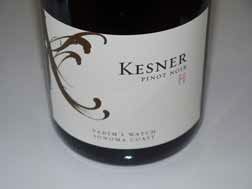 2013 Kesner Vadim’s Watch Sonoma Coast Pinot Noir 13.8% alc., $65. Whole berry, native yeast fermentation. Only free-run juice. Aged 16 months sur lie in 25% newer French oak barrels. · Moderately dark reddish purple color in the glass. The nose leads off with aromas of cherry, baking spices and complimentary oak. A lovely wine with great purity of fruit and refinement, offering plenty of black cherry and plum flavor touched by toasty oak. Very charming and silky on the palate with juicy acidity that lifts the fruit. The aromas and flavors changed considerably over time. More delicate than the 2012 version of this wine, but equally inviting. Score: 92
2012 Kesner King’s Russian River Valley Pinot Noir 14.2% alc., $60. · Moderate reddish purple color in the glass. The nose offers a pleasant marriage of black raspberry and black cherry fruit and sweet oak aromas. Impressive attack of blueberry, black raspberry and black cherry fruit flavors underlain with a compliment of integrated oak and spice. Well-composed with balanced tannins and admirable acid integration creating a seamless drinking experience. Curiously, when re-tasted the following day and two days later from a previously opened and re-corked bottle, the wine had taken on a herbaceous tone. Score: 89
2013 Kesner King’s Russian River Valley Pinot Noir 13.6% alc., $60. Whole berry, native yeast fermentation. Only free-run juice. Aged 16 months sur lie in 20% newer French oak barrels. · Moderate reddish purple color in the glass. A charming wine with aromas and flavors of dark red cherries, cranberry, spice and toasty oak. Discreetly concentrated, with modest tannins and good acid verve. Unchanged the following day from a previously opened and re-corked bottle. Score: 90
2014 Kesner Halfmile Sonoma Coast Pinot Noir 13.8% alc., $60. Release spring 2016. · Moderately dark reddish purple color in the glass. Complex aromatic profile, featuring scents of black cherry, blackberry, black currant, purple grape, spice cake and earthy flora. Heavily endowed with oak flavor at present, becoming less evident over time in the glass. The mid weight core of darker stone and berry fruits pick up weight and presence over time. Modest tannins, lively acidity and a welcome finish. This wine is not yet ready for prime time, explaining the future release. Score: 88-90
LaRue Wines
2013 LaRue Sonoma Coast Pinot Noir 12.9% alc., 235 cases, $60. A blend of grapes from Rice-Spivak (Dijon clones and Swan selection) and Emmaline Ann (Dijon clones) vineyards. Aged for 20 months in 100% French oak barrels, 30% new. · Moderate reddish purple color in the glass. The nose leads with aromas of cherry, wilted rose, tobacco and spice. Whole cluster inclusion is evident in the array of flavors that include dark berries, black cherry, black plum, and a hint of stem. Intense entry, attack and finish with prominent citrus-fueled acidity in the background. The acidity sticks out as sharp and steely, particular on the lemony finish. Score: 89
2013 LaRue Emmaline Ann Vineyard Sonoma Coast Pinot Noir 12.8% alc., 52 cases, $70. From a 3-acre vineyard near the town of Freestone. Dijon clones planted in Goldridge sandy loam. Aged 20 months in 100% French oak barrels, 50% new. · Moderately light reddish purple color in the glass. Enticing aromas of macerated cherries, rose petal, nutmeg and Christmas spices. All silk and satin on the palate with a lip-smacking core of black cherry and black raspberry fruit accented with a touch of stem and oak. A citrus-driven acidity note hovers in the background that leads to a mildly tart finish. The acidity is noticeable but better integrated than in the Sonoma Coast bottling. Score: 90
LUMOS
2013 LUMOS Five Blocks Wren & Temperance Hill Willamette Valley Pinot Noir 13.2% alc., 290 cases, $25. Release January 1, 2016. Certified organic vineyards. Vegan-friendly. Sourced from the 15-acre Wren Vineyard planted to Pommard clone Pinot Noir, located on grower and winemaker Dai Crisp’s 100-acre family farm, and the 100-acre Temperance Hill Vineyard. · Moderate reddish purple color in the glass. Very inviting aromas of cherry, forest floor and a hint of tobacco-laden oak. Vivid and crisp, with black cherry, black raspberry and spice really popping on the palate. Amazing grip and persistence on an incredibly long finish. Beautifully crafted, with integrated tannins and deft oak seasoning. An incredible wine at this price. Score: 92
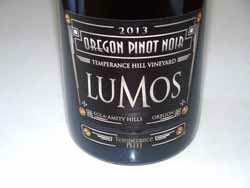 2013 LUMOS Temperance Hill Vineyard Eola-Amity Hills Willamette Valley Pinot Noir 13.2% alc., 143 cases, $45. Release January 1, 2016. Vineyard is USDA certified organic. Vegan-friendly. · Moderately dark reddish purple color in the glass. Inviting perfume of dark berries and pie cherries with an earthy underpinning. Heavenly flavors of marionberry, plum, pomegranate and spice that fills the mouth with layers of goodness. This wine comes at you from all angles and refuses to leave on the fruit-laden finish. A Pinot Noir that is both husky and masculine, yet refined and sophisticated. The serious fruit intensity is deftly balanced by a tannic backbone that insures age ability. I can’t say enough good things about this special wine. Score: 94
MacPhail Family Wines
2013 MacPhail Tolouse Vineyard Anderson Valley Pinot Noir 14.7% alc., pH 3.78, TA 0.58, 503 cases, $49. Harvest Brix 23.6º to 25.5º. Clones 2A, Pommard, 115, 667 and 777. 100% de-stemmed, 5-day cold soak, native and proprietary yeast primary fermentation, native malolactic fermentation in barrel, batonage weekly for 3 months, aged 11 months sur lie in 100% French oak barrels, 40% new. Bottled unfined and lightly filtered. · Moderate reddish purple color in the glass. Shy, but pleasing aromas of black cherry, plum and rose petals. Bright acidity drives the palate that is replete with flavors of dark red cherry and berries and a deft note of oak. Supple tannins make for easy drinking, and the finish is particularly pleasing with a burst of Bing cherry and a tight grip. Even better the following day from a previously opened and re-corked bottle. Score: 90
2013 MacPhail Wightman House Vineyard Anderson Valley Pinot Noir 14.7% alc., pH 3.79, TA 0.55, 95 cases, $55. Harvest Brix 23.5º. Martini clone. 100% de-stemmed, 5-day cold soak, proprietary yeast primary fermentation, native malolactic fermentation in barrel, aged 11 months sur lie in 100% French oak barrels, 50% new. Bottled unfined and unfiltered. · Moderate reddish purple color in the glass. Nicely perfumed with elevating aromas of cherry, raspberry and sous-bois. Very silky on the palate, with plenty of personality, featuring mid weight flavors of black cherry, blackberry, anise and black tea. Impressive fruit presence in a beautifully balanced wine that aims to please. Score: 91
2013 MacPhail Lakeview Vineyard Green Valley of Russian River Valley Pinot Noir 14.5% alc., pH 3.58, TA 0.58, 192 cases, $49. Inaugural release from this 8.6-acre vineyard planted in Goldridge sand loam soil. Harvest Brix 24.5º. Clones 114 and 115. 84% de-stemmed, 5-day cold soak, native and proprietary yeast fermentation, native malolactic fermentation in barrel, batonage weekly for 3 months, aged 16 months sur lie in 100% French oak barrels, 37% new. Unfined and lightly filtered. · Moderately light reddish purple color in the glass. The nose reminds one of the holidays, with aromas of cherries, berries and Christmas spice. Delicious Bing cherry fruit floods the mouth with a bit of purple berry and spice chiming in. The tannins are soft and balanced, the mouthfeel is all velvet, and the extraordinarily intense finish made me sit up in my chair. Still prodigious the following day from a previously opened and re-corked bottle, with all components working in perfect harmony. Score: 94
Ponzi Vineyards
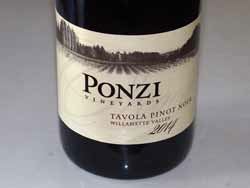 2014 Ponzi Vineyards Tavola Willamette Valley Pinot Noir 13.7% alc., $25, screwcap. Sourced from multiple sustainably-grown vineyards throughout the Willamette Valley. Extended cold soak, native yeast fermentation, aged in French oak barrels, 20% new, for 11 months. Unfined and unfiltered. Aged 7 months in bottle before release. · Moderate reddish purple color in the glass. Highly fragrant with aromas of black cherry, black raspberry, cola and toasty oak leaping from the glass. Noticeably fresh and energetic, with a juicy core of cherry fruit augmented with a light touch of oak. Beautifully integrated acidity drives the palate in the forward-drinking, food-friendly and enjoyable wine. Score: 89
2013 Ponzi Vineyards Willamette Valley Pinot Noir 13.2% alc., pH 3.68, $40. Released September 2015. A blend from Ponzi’s Aurora and Avellana vineyards as well as nine other vineyards. 5-day cold soak, aged 11 months in French oak barrels, 35% new, and aged 5 months in bottle. Unfined and unfiltered. · Moderate reddish purple color in the glass. Very little black cherry fruit on the nose with a strong cigar box scent. Mid weight core of black cherry fruit with complimentary oak and spice accents, backed by svelte tannins. Easy to drink, with a modest finish. Score: 87
2013 Ponzi Vineyards Reserve Willamette Valley Pinot Noir 13.6% alc., pH 3.55, 1,250 cases, $60. A blend of LIVE Certified Sustainable fruit from Ponzi’s Aurora, Abetina and Madrona vineyards, as well as fruit from Linda Vista, Kason, Zenith and Walnut Ridge vineyards. Primarily grapes grown in Laurelwood soils in the Chehalem Mountains AVA. 100% de-stemmed, 5-day cold soak, 7-day post-fermentation maceration, and aged for 20 months in French oak barrels, 30% new. Bottled unfined and unfiltered and aged an additional 5 months before release. · Moderately light reddish purple color in the glass. Shy, but pleasing aromas of cherry, raspberry, herbs, nuts and nori. The array of darker red cherry and berry fruit really sparkles on the palate which offers added accents of black tea, savory dried herbs and toasty oak. Silky tannins add a seductive mouthfeel. This is a giving wine upon opening, but becomes noticeably better over time in the glass. Decant or hold in your cellar for full enjoyment. Score: 91
Privé Vineyard
2014 Privé Vineyard le nord Estate Grown Chehalem Mountains Willamette Valley Pinot Noir 13.8% alc., $50. 100% old vine Pommard. · Moderately light reddish purple color in the glass. Nicely perfumed with aromas of dark cherry, cola and complimentary oak. An appealing marriage of dark red cherry and berry fruits, oak vanillin and acid along with a firm, balanced tannic backbone. The finish offers lip-smacking acidity and a bit of alcoholic warmth. The fruit is not as expressive as it will be and the oak is more expressive than it will be. When tasted the following day from a previously opened and re-corked bottle, the wine was a little more showy. Score: 90-91
2014 Privé Vineyard le sud Estate Grown Chehalem Mountains Willamette Valley Pinot Noir 13.9% alc., $60. · Moderately light reddish purple color in the glass. Aromas of red cherry and sandalwood lead to a charge of dark red fruits that offer a luscious expression of dark cherry fruit. More assertive than le nord, with a finish that really grabs your attention. When tasted the following day from a previously opened and re-corked bottle, the aromas of dark cherry and spice were intoxicating and the elegantly delivered cherry and spice flavors were more inviting. Score: 90-91
Red CarRed Car has enjoyed a remarkable transformation since its early wines in the mid 2000s which were significantly more extracted, more hedonistic, with higher alcohols and lower acidity. Now concentrating solely on Sonoma Coast grape sources (“on the edge of the Pacific” as the website notes), Red Car is producing wines that are more artfully and delicately balanced with more discreet extraction, lower alcohols and more vivid acidity. There is more terroir speaking in the current wines and each wine has a distinct individualistic character. All wines are vinified with wild yeast, gravity flow, and natural acidity. One never thinks oak when tasting these stellar wines. Also, check out the latest Chardonnay releases (reviewed in this issue) as they are really stellar. The back labels of the current vintages are a model for other wineries to follow. They are very informative, with all the important information displayed and no BS.
2013 Red Car Sonoma Coast Pinot Noir 13.3% alc.,TA 0.57, $45. Sourced from several vineyards: Red Car Estate (21%), Platt (19%), Bohemian Station (18%), Falstaff (12%), Riddle Ranch (12%), Hagan (11%) and Clary Ranch (7%). Average harvest Brix 22.5º. Calera, “828,” 777, 115, Pommard and Schoolhouse clones. Aged in 10% new and 90% neutral French oak barrels. · Moderate reddish purple color in the glass. Dark red berries and cherries are featured in this mid weight wine that is smooth on the palate, nicely balanced, and offers a lip-smacking cut of acidity on the finish. An admirable reflection of the Sonoma Coast in this vintage. Score: 90
2013 Red Car Platt Vineyard Sonoma Coast Pinot Noir 13.0% alc., 495 cases, $68. This vineyard overlooks the town of Bodega, 5 miles inland from the Pacific Ocean. Average harvest Brix 21.9º. Calera and “828” clones planted in Goldridge sandy loam. 10% whole cluster. Aged 12 months in 20% new and 80% neutral French oak barrels. · Moderately light reddish purple color in the glass. Enthralling nose that really drew me into the glass with aromas of red berries, brier, rose petal and spice. Lighter weighted, but generously endowed with vivid strawberry, raspberry, red cherry and spice flavors backed by juicy acidity and backseat tannins. Impeccable balance in this deftly composed and classy wine. Score: 93
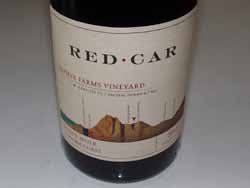 2013 Red Car Zephyr Farms Vineyard Sonoma Coast Pinot Noir 13.8% alc., TA 0.51, 388 cases, $68. Vineyard is located 6.7 miles from the Pacific Ocean in the hills above Freestone. Average harvest Brix 23º. Clones 777, 667 and 115 planted in Goldridge sandy loam. 10% whole cluster. Aged 12 months in 13% new and 87% neutral French oak barrels. · Moderate reddish purple color in the glass. Enticing aromas of purple berries, purple grapes and damp earth bring persistence on the nose. Silky and long on the palate, with flavors of black cherry, ollaliberry and spice. Nicely ripened fruit with phenolic majesty and welcome brightness. Modest tannins make for easy drinking now, and the juicy cut leads to a mouthwatering finish. Score: 93
2013 Red Car Hagan Vineyard Sonoma Coast Pinot Noir 13.2% alc., TA 0.51, 380 cases, $68. Vineyard is located 4.6 miles from the Pacific Ocean on a windswept ridge at 850 feet. Average harvest Brix 22º. Calera, 777 and 115 clones planted in Goldridge sandy loam. 11% whole cluster. Aged 12 months in 27% new and 73% neutral French oak barrels. · Moderate reddish purple color in the glass. Reserved nose offering demure aromas of black cherry, briar and rose petal. Delicious core of vivid black cherry and black raspberry fruits that saturate the palate and persist through a remarkably intense finish that really grabs hold. Seductively silky with fine-grain tannins and a savory riff of spice. Score: 92
2013 Red Car Doc’s Ranch Vineyard Sonoma Coast Pinot Noir 12.5% alc., TA 0.51, 75 cases, $68. This vineyard is located at 900 feet elevation, 4.7 miles from the Pacific Ocean. Swan clone planted in Yorkville loam soil. Average Harvest Brix 21.8º. 10% whole cluster. Aged 12 months in 100% neutral French oak barrels. · Moderately light cherry red color in the glass. Aromas of red fruits, wilted rose and spice lead to a lightly weighted palate of cranberry, strawberry and raspberry fruits. Very delicate, with good cut on the very modest finish. A very pretty wine that is well-crafted, but doesn’t have enough to hold my full attention. Apparently this was all the vineyard could give in this vintage. Score: 89
small + tall
2012 small + tall “Joyful” Clos Pepe Vineyard Sta. Rita Hills Pinot Noir 14.1% alc., $60. Clone 115. 100% de-stemmed, 4 to 6-day cold soak, native fermentation, aged 16 months in French oak barrels on the lees. · Moderate reddish purple hue in the glass. Aromas of cherry, strawberry and doughy oak are prominent initially, with the fruit becoming less expressive over time in the glass. Enviable entry and attack of strawberry, raspberry and cherry fruits accented with herbs and oak. The tannins are supported without being intrusive, and the dry finish continues the red berry and cherry theme. Satisfactory, even very good, but not special. Score: 89
 2012 small + tall “Little Joy” Garey Vineyard Santa Maria Valley Pinot Noir 13.5% alc., $48. Clone 777. 100% de-stemmed, 4 to 6-day cold soak, native fermentation, aged 16 months in French oak barrels (0% new). · Moderately light reddish purple color in the glass. Embracing aromas of cherries and berries with a compliment of oak. Relatively light in weight but quite flavorful, featuring red fruits brought to life with juicy acidity. Quite expressive, particularly on the lengthy finish. Plenty of Pinot singing in this wine. Score: 91
Stolo Family Vineyards
2013 Stolo Family Vineyards Estate Creekside Vineyard San Luis Obispo County Pinot Noir 14.5% alc., 375 cases, $32. Vineyard planted in 2008 in Cambria less than 3 miles from the Pacific Ocean. 100% sustainably farmed by hand. Pommard clone. Harvest Brix 24.5º. Aged 10 months in 25% new French and Hungarian oak barrels. · Moderately light reddish purple color in the glass. This is an oak-infused wine featuring a middleweight core of black cherry and pomegranate fruits, well-proportioned tannins, and some intensity on the lively finish. Score: 87
2013 Stolo Family Vineyards Estate Hillside Reserve San Luis Obispo County Pinot Noir 14.5% alc., 164 cases, $42. Vines planted in 1998 less than 3 miles from the Pacific Ocean. 100% sustainably farmed by hand. Clone 115. Harvest Brix 26.1º. Aged 10 months in 30% new French oak barrels. · Moderately dark reddish purple color in the glass. Aromas of ripe black cherry, blackberry, anise and forest floor. Plush, generous and silky on the palate, with considerable tobacco-tinged oak infusing the dark fruited core of fruit. The wine is forward drinking with modest tannins and some finishing length. Score: 88
Other
2013 BARRA of Mendocino Estate Grown Mendocino Pinot Noir 14.0% alc., pH 3.61, TA 0.64, 876 cases, $20. Harvest Brix 23.3º. Certified organic grapes. · Moderately light cherry red color in the glass. Inviting aromas of cherry, baking spice and underbrush. Light to mid weight essence of fresh red cherry and cranberry fruits backed by ruddy tannins. A thread of herbal oak runs through the background. Bright and food friendly with some finishing length. Score: 88
NV Chateau La Paws California Pinot Noir 13% alc., pH 3.65, TA 0.53, $12.99. Produced by Rosenblum Cellars. Profits proudly support No Kill Shelters. Aged in French and American oak barrels. Contains a small amount of Syrah (13%). · Moderate reddish purple color in the glass. The nose is devoid of fruit, offering only briar and oak char aromas. Somewhat more inviting on the palate, with mid weight plus flavors of black cherry and strawberry that have a porto character and are framed by an unpleasant burnt caramel flavor. Score: 85
2013 Girasole Vineyards Mendocino Pinot Noir 13.8% alc., pH 3.61, TA 0.62, 6,000 cases, $15. Harvest Brix 24.7º. Estate grown, certified organic grapes, vegan. · Moderately light reddish purple color in the glass. Aromas of cherry combined with oak-driven notes of ash and vanilla. Delicately fruited, featuring a black cherry core with smoky oak in the background. Modest mid palate attack with a cherry-driven finish dominated by charred oak. Score: 85
2013 Hagafen Cellars Coombsville Napa Valley Pinot Noir 13.5% alc., pH 3.46, TA 0.58, 900 cases, $32. Harvest Brix 23.1º. · Moderately dark reddish purple color in the glass. The nose offers demure red fruits and dominating oak-driven vanilla and spice. The cranberry, strawberry and Damsel plum fruits are well supported by matched tannins, the mouthfeel is plush, and there is a reasonably long finish that features vanilla-scented oak. This wine will appeal most to those who welcome lavishly oaked Pinot. Score: 86
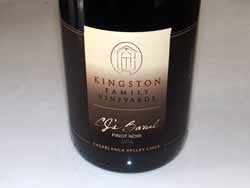 2014 Kingston Family Vineyards “CJ’s” Barrel Casablanca Valley Chile Pinot Noir 12.5% alc., 75 cases, $38. One of only a handful of Chilean vineyards leveraging artisan winemaking and sustainable viticultural techniques to uncover the potential of cool climate Pinot Noir. This bottling is named after CJ Kingston, a family patriarch and pioneer who came to Casablanca in the early 1900s looking for gold. This is an extremely limited special bottling, allocated to Old Corral club members and available only direct from the winery. Aged 10 months in French oak barrels. · Moderately light reddish purple color in the glass. Nicely perfumed with bright aromas of fresh dark cherries, sous-bois and mocha. Very soft in the mouth and quite charming, with a succulent core of dark cherry, fig and nutty oak flavors dressed in suave tannins. Light on its feet and a pleasure to drink. Score: 90
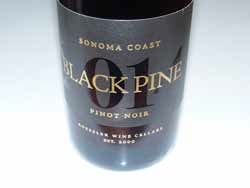 2014 Roessler Wine Cellars Black Pine Sonoma Coast Pinot Noir 14.1% alc., pH 3.67, TA 0.55,2,400 cases, $26. Release January 1, 2016. From R2 Wine Company in Sonoma founded by Richard and Roger Roessler. “Black Pine” is literally the English translation of the words Pinot Noir. Aged 10 months in 20% new French oak barrels. · Moderate reddish purple color in the glass. A beautifully structured and harmonious wine with aromas of black cherry, rose petal and earthy flora, and mid weight juicy flavors of black cherry, cola, spice and mocha. Expansive on the palate with impressive finishing power. A terrific value @ www.r2winecompany.com. Score: 90
2014 Trader Joe’s Lot #57 Estate Grand Reserve Russian River Valley Pinot Noir 14.2% alc., $14.99. Cellared and bottled by DNA Vineyards, Ukiah, CA. · Moderately light reddish purple color in the glass. Deep aromas of Bing cherry, spice and toasty oak. Quintessential Russian River Valley in character, with mid weight flavors of black cherry, cola and spice. This wine has noticeable power and intensity on the palate and finish with a compliment of oak in the background. An easy drinking wine with substance that won’t disappoint at this price point. Score: 88
2014 Upper Eden Santa Lucia Highlands Pinot Noir 14.8% alc., $12.99. A Trader Joe’s exclusive from Upper Eden Wines in Soledad. · Moderately light reddish purple color in the glass. The nose did not appeal, with aromas of dried cherry, pitch and underbrush. Better on the palate, with middleweight flavor of black cherry, RC Cola and an accent of toasty oak. Structured, with good integration of the alcohol, and a modest finish. Score: 86
Sips of Recently Tasted Chardonnay
NV Chateau La Paws California Chardonnay 13.0% alc., $12.99. · Light golden yellow color in the glass. Aromas of apple, lemon peel and vanilla are echoed on the palate with added tastes of pineapple and pastry creme. Slightly creamy with balanced acidity, finishing with a slight medicinal note. Score: 86
13.9% alc., pH 3.34, TA 0.70, 311 cases, $50. The Old Wente vines at this vineyard have been used since 2006 for the Dutton Ranch Chardonnay, but a designated bottling had to be done in this vintage. Primarily indigenous fermented barrels, extended malolactic fermentation, and aged 16 months in French oak barrels, 50% new. · Moderately light golden yellow color and clear in the glass. A bright, crisp and suave wine that offers aromas of lemon water, apple, oregano and toast, and flavors of citrus, apple butter, baking spices and cashew butter. A subtle hint of oak chimes in. Smooth in the mouth with bright lemon-lime acidity in the background. Score: 92
2013 Dutton Goldfield Rued Vineyard Russian River Valley Chardonnay 13.8% alc., pH 3.34, TA 0.68, 815 cases, $50. This vineyard was planted by Warren Dutton in 1969. Intended to be budded as Old Wente selection, it turned out that half of the wood he received was a so called “Chardonnay musqué” selection. The selection has since been propagated across California and is referred to as the Rued clone. It is not truly a clone, but a selection propagated from preferred vineyard cuttings. Vines are planted in sandy Goldridge series soil and are dry farmed. 100% barrel fermented with mostly native yeasts, full malolactic fermentation, and aged 17 months with lees stirring in French oak barrels, 50% new. Unfiltered. · Moderately light golden yellow color and clear in the glass. Aromas of iron, lemon oil, and tropical fruits. Creamy on the palate, with discretely rich flavors of lemon creme, creme brulee flavors and nutty oak, framed by just the right amount of cut. A serene wine with plenty of white-fleshed fruit on the uptown finish. Score: 92
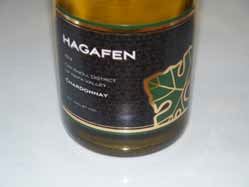 2013 Hagafen Oak Knoll District of Napa Valley Chardonnay 14.6% alc., $30. Sourced from Hall Vineyard. Aged in partial neutral American oak for 6 months. · Moderate golden yellow color in the glass. A solid offering from the first kosher winery in Napa Valley featuring aromas of buttery citrus, peach, yellow apple and vanilla. Highly flavorful on the palate with tastes of lemon cake, pear and green apple that persist through a satisfying finish sporting cleansing acidity. Slightly viscous in the mouth, with a hint of dry tannin. Score: 90
2012 Kesner Rockbreak Sonoma Coast Chardonnay 14.3% alc., $60. · Moderate golden yellow color in the glass. The nose leads with scents of green apple, carrot cake and bake shop. Silky and satisfying on the palate, with flavors of lemon creme, pear, spice, caramel and toast. The wine finishes with a good grip of palate cleansing acidity. Score: 89
2013 Kesner Rockbreak Sonoma Coast Chardonnay 13.7% alc., $60. Sourced from Idell Vineyard exposed to cool Pacific Ocean winds and fog. Native fermentation in barrel, natural acidity, aged in 20% newer French oak barrels. · Moderate golden yellow color in the glass. A bit of matchstick reduction upon opening which dissipates, leading to aromas of grilled lemon, stone fruit and smoky, toasty oak. Lovely fruit flavors including lemon, yellow peach, brioche, spice and light caramel with an appealing flinty note. Noticeable length on the finish which offers a refreshing cut of acidity. Score: 90
2013 Kesner Heintz Vineyard Sonoma Coast Chardonnay 14.2% alc., $60. The proximity to the coast and the cool microclimate of the site make this the last harvested fruit of the year as time was needed for the acids to calm in the cool coastal evenings leading up to the picking. Native fermentation in barrel, natural acids, aged in 20% newer French oak barrels. · Moderate golden yellow color in the glass. A tightly wound wine with aromas of lemon oil, lees and peeled bark along with flavors of lemon, grapefruit and white peach. Acid-driven on the palate, with a refreshing hi-pitched finish. Score: 90
2013 MacPhail Pratt Vineyard Vine Hill Road Russian River Valley Chardonnay 14.4% alc., pH 3.50, TA 0.57, RS .13 gms/100 ml, 289 cases, $45. Released fall 2015. This vineyard is located on the edge of Green Valley near Forestville in the Laguna Hills region. Goldridge soil. Harvest Brix 23.3º. Mt. Eden, Robert Young and Dijon 96 clones. · Light golden yellow color in the glass. The nose offers pleasing aromas of citrus, apple and brioche. The palate is rich and lush, filled with grilled lemon, poached pear, baked apple, tropical fruit and caramel flavors. Slightly viscous, this ripe styled wine finishes long and clean. Score: 89
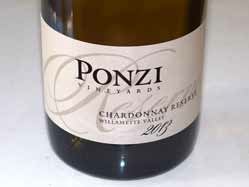 2013 Ponzi Reserve Willamette Valley Chardonnay 13.4% alc., pH 3.46, 1,350 cases, $35. Released July 2015. A blend of LIVE Certified Sustainable fruit from Ponzi’s Aurora and Avellana vineyards, as well as fruit from Sunset View and Thistle vineyards. Whole cluster pressed, barrel fermented using partial wild yeast. 100% malolactic fermentation. Lees stirring once a week for 6 months and racked after 12 months to neutral oak. After 20 months of barrel age, blended and bottled. Aged in bottle 3 months before release. · Moderately light golden yellow color in the glass. Appealing aromas of lemon-lime soda, lemon curd, brioche and saline. Slightly viscous on the palate and very suave and clean, with flavors of lemon, yellow apple, spice and vanilla wafer. Gorgeous balance with a bright, citrus driven finish of uncommon length for a Chardonnay. Score: 92
2013 Red Car Sonoma Coast Chardonnay 13.4% alc., pH 3.38, TA 0.75, $38. A blend of grapes from five vineyards with Weeks (42%) and Ritchie (28%) making up the highest percentage. Old Wente clone. Harvest Brix 21.9º. Aged in French oak barrels, 3% new and 97% neutral. · Moderate golden yellow color and clear in the glass. Nicely appointed aromas of lemon oil, buttery brioche, tarte tartin and nutty oak. Good richness of flavor featuring tastes of lemon creme pie, brown butter and vanilla backed by racy acidity. The intense mid palate attack builds to a focused and bright lemony, slightly tart, lip-smacking finish. Score: 91
2013 Red Car Hagan Vineyard Sonoma Coast Chardonnay 13.6% alc., pH 3.50, TA 0.59, 75 cases, $58. Grapes harvested from a 1.5-acre section of the organically farmed vineyard planted to Old Wente clone. Yields were half of what was harvested in 2012. Aged 14 months in French oak barrels, 33% new and 67% neutral. · Moderate golden yellow color and clear in the glass. Inviting aromas of golden apple, nutty oak and stony minerality. Slightly viscous and very harmonious on the palate, with flavors of lemon, golden apple tart and caramel. Perfectly integrated acidity with a satiny finish filled with yellow fruit goodness. Score: 91
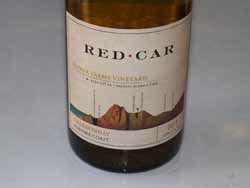 2013 Red Car Zephyr Farms Vineyard Sonoma Coast Chardonnay 13.8% alc., pH 3.20, TA 0.84,100 cases, $58. Grapes picked at naturally high acid levels in this vintage. Prosser clone planted in Goldridge sandy loam. Harvest Brix 22.6º. Aged 14 months in French oak barrels, 25% new and 75% neutral. · Moderate golden yellow color and clear in the glass. Lovely aromas of lemon peel, cut apple and pastry cream arrive slowly over time in the glass. Instantly giving on the palate, with delicious flavors of lemon, grapefruit, green apple and toffee complimented by the faintest oak. The racy finish is incredibly focused, long and intense. Vivid, vibrant and refreshing. Score: 94
2013 Red Car Ritchie Vineyard Sonoma Coast Chardonnay 13.6% alc., pH 3.45, TA 0.66, $58. Old Wente clone planted in Goldridge sandy loam. Harvest Brix 22.3º. Aged 14 months in French oak barrels, 28% new, 72% neutral. · Moderate golden yellow color and clear in the glass. The aromas are captivating, featuring lemon oil, white peach, butter oak, creme fraiche and flint. Soft on the palate with perfectly integrated acidity enhancing the flavors of lemon, apple, baking spices, and buttered toast. The fruit really stands out for its class, and is on full display on the soprano finish. Score: 94
Rhys Vineyards is known for their Pinot Noir and rightfully so, but I have found their Chardonnays particularly appealing over the years. I have believed for some time that the potential for Chardonnay in the Santa Cruz Mountains exceeds that of all other wine regions of California except maybe the Sonoma Coast. Chardonnay plantings at Rhys Vineyards have increased steadily since a single acre was planted at Alpine Vineyard in 2000. Currently, there are 2.75 acres at Alpine Vineyard and 4 acres at Horseshoe Vineyard, both in the Santa Cruz Mountains, and 8 acres at Bearwallow Vineyard in the Anderson Valley. The Chardonnay vines have been planted in some of the best soils and enjoy some of the best exposures found at each site. The vines are tightly spaced with low vigor rootstock onto which they have grafted a massale (field mixture) of four heritage selections of Chardonnay (including Wente, Hyde and Mt. Eden). The tight spacing forces the vines to fully explore the soil profile and the 18!-24! of rocky topsoil over Monterey Shale forces the vine to concentrate its efforts on very small berries, while the mixture of Chardonnay selections contributes to an orchestration of expression. The Chardonnays are gently whole cluster pressed, the must is settled overnight, and the barrels filled by gravity the following morning. The wine is fermented and aged in French oak barrels, 20%-25% new where it is left undisturbed without batonnage in a temperature-controlled white barrel room, completing a native yeast fermentation that can sometimes take an entire year. According to a recent Rhys Vineyards! newsletter, 2015 is Alpine Vineyard!s 15th birthday and clearly the vineyard “has been going from strength to strength as the vines have aged.” The mature vines have better balance and more resilience to extreme weather. The vines are essentially dry farmed now even in the extreme drought conditions of recent vintages. Sometimes while tasting wine, I come across a wine that is clearly better than even many other superb wines. This was the case when I tasted the 2013 Rhys Vineyards Alpine Vineyard Chardonnay. The wine was so striking and emotive, I felt challenged to give the wine a proper description.

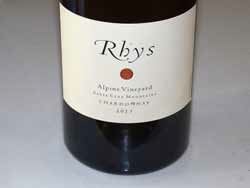 2013 Rhys Vineyards Alpine Vineyard Chardonnay 13.5% alc., $69. · Light golden yellow color in the glass. Gorgeous and intoxicating aromas of lemon, pineapple, yellow peach and crushed chalk. Equally sensational on the palate with a perfect marriage of luscious lemon cake, pineapple and pear flavors with uplifting acidity. A hint of complimentary nutty, vanillin oak adds to the appeal of this laser focused wine. The finish is incredibly long and refreshingly racy. I was so taken by this wine, that I stopped tasting other wines on this day and had a generous glass with lunch. A delicious, edgy wine without rival. (BTW, I did not see the glowing reviews of this wine by other notable wine critics before tasting this wine) Score: 99
2012 small + tall Clos Pepe Vineyard “Liquid Joy” Sta. Rita Hills Chardonnay $30. Dijon 76 and Wente clones. Pressed to neutral French oak barrels and stainless steel barrels and cool fermented with native yeast. Aged 16 months on the lees. Oak and stainless steel lots blended before bottling. Whole cluster pressed to barrel, native and proprietary yeast fermentation (50/50), 100% malolactic fermentation, aged sur lie for 17 months in French oak barrels. Bottled unfined and unfiltered. 13.5% alc., $. · Light golden yellow color in the glass with a slight haze. The aromatic profile was unusual and hard to describe but included aromas of lemongrass and nutty granola. Flavors of lemon cake, apple, marzipan and toast are framed by a vibrant acidity. An unpretentious, every day style. Score: 87
2012 and 2013 Scherrer Helfer Vineyard Russian River Valley Chardonnay See feature on Scherrer Winery in this issue for these two reviews.
Pinot BriefsNouveau Pinot Wine drinkers are familiar with Beaujolais Nouveau, traditionally released today, the third Thursday of November to celebrate the year’s harvest. Now that the novelty of Pinot Noir Blanc has worn off, Pinot Noir producers are turning to another option, “Pinot Nouveau.” For the past three years, Poe has being making a Pinot Nouveau from Pinot Noir instead of Gamay, using the same winemaking techniques of Beaujolais Nouveau including carbonic fermentation. The 2015 Poe version from Sonoma Coast grapes was released about the same time as Beaujolais Nouveau in time for Thanksgiving ($22). The grapes were sourced from dry farmed and head trained Olcese Vineyard in Sonoma planted to Martini clone in 1974. Whole clusters are put in a portable fermenter and the lid sealed for 7 weeks. Absent oxygen, the grapes undergo carbonic fermentation and malolactic fermentation at the same time. The grapes are then pressed and go to barrel for 1 week. The wine is hand bottled without any sulfur as the wine is to be consumed within the next 2 to 3 months. Meiomi Wines also released a Pinot Nouveau labeled as Nouveau Jeunesse with the 2015 vintage now available in wide distribution including Trader Vic’s stores ($18.99). This wine is made from the same grapes that are picked for Meiomi Pinot Noir from vineyards throughout Sonoma, Monterey and Santa Barbara counties. Immediately after fermentation, the wine is bottled and shipped straight to market. It is meant to be enjoyed young and not cellared.
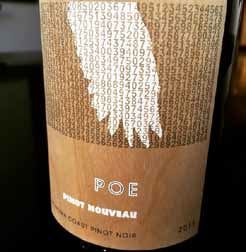 Byron Undergoing Transformation Byron is shedding its more popularly priced appellation wines that will now be under a new label called Nielson and are returning to their original focus on small bottlings of single vineyard Pinot Noir from premium Santa Barbara County vineyards. Besides their iconic estate Nielson Vineyard and flagship Santa Maria Valley vineyards (Bien Nacido and Julia’s), winemaker Jonathan Nagy of Byron will also produce single vineyard Pinot Noir from Sta. Rita Hills sites including John Sebastiano, Rita’s Crown and La Encantada. The new Byron wines won’t be released until next year in the early fall. Umpqua Winemaker Raises $1 million in Crowd Funding for New Pinot Noirs Winemaker Scott Kelley, formerly the winemaker for Robert Mondavi Family Wines and Estancia, has struck out on his own and using a crowd funding platform to launch a southern Oregon winery featuring Pinot Noir. He is using NakedWines.com which supports the independent wine market. Winemakers are invested in by the consumer, the so-called “angel,” and in return, they get dibs on delicious wines at wholesale prices delivered to their door. The investment of $40 a month in NakedWines as an “angel” goes toward a wine purchase and the company then invests that money in top winemakers who make wine exclusively for NakedWines.com. Winemaker Scott Kelley has raised more than $1 million on the NakedWines.com site to start his own label. Visit www.nakedwines.com for further details. Scott Kelley and Dyson DeMara (HillCrest Winery and Distillary) plan to make Pinot Noir, red Bordeaux blends, Syrah, Chardonnay and Riesling at Paul O’Brien Winery in Roseburg, Oregon, under the Paul O’Brien Winery label. The two have been friends since 1999 when they met at Robert Mondavi Winery. Paul 0’Brien Winery is the first urban winery in the Umpqua Valley. Bill Fuller Oral History Interview Available As part of the ongoing Oregon wine history project at Linfield College in McMinnville, Oregon, an interview of Oregon winemaking pioneer Bill Fuller was recorded August 11, 2015, and is now live and can be viewed at www.youtube.com/user/LinfieldArchives Wine Kloud Wine industry distributor veterans Darian Wilson and Rich Martini co-founded Wine Kloud, a consumer friendly website that curates the best wine deals available nationwide. The site is linked to over 1,000 retailers and publishes between 200 to 600+ new deal daily. No one else is doing this for consumers. Wine Kloud is not a retailer, but rather a place where consumers can find the best deals on wine. Users browse on Wine Kloud and then buy direct from the selected retailer who is offering the daily deal, at no added cost. Users can set up a profile of personal searchers, as well as track wines and retailers of their choosing via the “wine tracker” and “alert settings,” and be notified immediately when their favorite wines and retailers hit the Deal Kloud. Think of it as the well known version of Slickdeals for purchasing wine. Slickdeals has become the leader in doing the same thing for electronics and now has over 5 million users. Premium membership is a nominal $25 a year and allows users to access even more daily deals, featuring wines with the highest scores and biggest discounts. Another Paris Judgment Movie The 40th anniversary of the Judgment of Paris occurs next year and a new movie claims to be the definitive film version of the Paris tasting. Writer Robert Kamen, a wine producer in Sonoma is beginning a search for actors. New Wine Series, “Uncorked” Esquire Network opened “Uncorked” on Tuesday, November 10. Based on the documentary “SOMM,” “Uncorked” chronicles the journey of six of New York’s hottest wine stewards as they attempt to pass the Master Sommelier test. For full episodes, clips, and photos, visit http:// tv.esquire.com/ekit/uncorked/#/. Each hour-long episode of this six-part docu-series will feature the wine stewards swirling, smelling and slurping a multitude of wines, and they also enter competitions overseen by Master Sommeliers. Only 230 people worldwide have passed the Master Sommelier test in its 40+ year history. 2015 California Winegrape Harvest Early and Light Despite reduced crop size compared to 2014, harvested grapes were of exceptional quality. According to the Wine Institute, 2015 was one of the earliest seasons on record. A mild winter caused early bud break, followed by protracted bloom and unseasonably cool weather in the spring, contributing to smaller grape cluster and variable crop size. Pinot Noir yields were especially low (see chart below). A compacted harvest began in July for sparkling wines and some still white wines, and was finished by most wineries by the end of September. This is only the third time since 1982 that harvest finished in September. Most vintners who were interviewed claimed that 2015 was a vintage of exceptional quality throughout California. The crop is estimated to be nearly 3.8 million tons.
 Latest Oregon Stats Amaze Latest statistics from Oregon compiled by the Southern Oregon University Research Center were reported in Oregon Wine Press (November 2015) by David Bates. Among the eye-opening numbers were the following. Overall production in 2014 was over 78,000 tons which represents an increase of 39 percent over 2013. This was the third consecutive year of double-digit gains. Pinot Noir production in 2014 was 45,239 tons, an increase from 32,239 tons in 2013. The total number of wineries grew to 676 and the number of vineyards topped 1,000 for the first time (1,027). Of the 27,390 acres planted to wine grapes, 15,356 acres were planted to Pinot Noir. Oregon now commands the highest averageper- bottle price of any wine region in the world ($15.59 compared to a nationwide average of less than $7.00). Oregon 2015 Vintage an Ideal Growing Season The Oregon Wine Industry reports that 2015 delivered “exceptional fruit quality.” Warm weather prevailed in the winter and continued throughout spring and summer. There were light showers in August, but normal weather in September. Harvest began about August 26 making this year’s harvest one of the earliest on record. There was minimal evidence of disease or bird problems. Harvest in the Willamette Valley finished by the end of September to early part of October. Yields were generally higher than normal. The warm growing season will undoubtedly produce some big Pinot Noirs
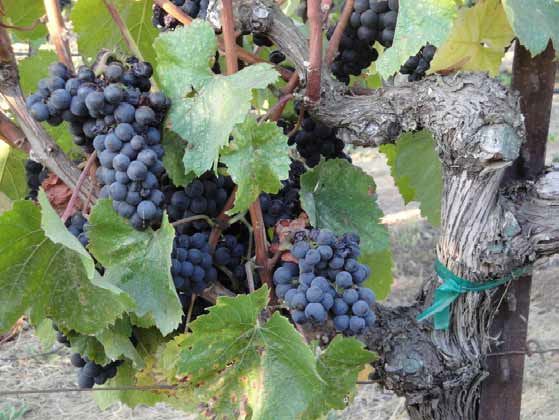 Chef Guy Fieri Enters Pinot Race According to gq.com, noted Food Network personality and restauranteur, Guy Fieri (“FEE-eddy”), who lives in Santa Rosa, California, has a wine label, Hunt & Ryde, named for his two sons, Hunter and Ryder. He plans to release three varietals including a Pinot Noir this fall and will add a sparkling rosé next year. The wines will be sold on the website, scheduled to go live around Thanksgiving. Fieri’s attempt to open a tasting room near his estate vineyard adjacent his home was opposed by his Willowside neighbors and was turned down by the planning board. Fieri’s winemaker partner on the project is respected Russian River Valley vintner Guy Davis of Davis Family Wines. Hudson Ranch to Add a Winery According to napavalleyregister.com (October 7, 2015), Carneros winegrower and produce farmer Lee Hudson is going to build a winery on his 167-acre property along Carneros Highway. Hudson has farmed in Carneros since 1981 and Hudson Vineyard designated Chardonnay in particular is highly sought after. The winery will include a tasting room so Hudson can accept visitors, taste Hudson wines, and he can build his brand. Hudson Wines at www.hudsonranch.com.
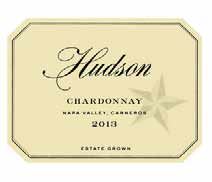 Willamette Valley Vineyards Offering Stock in New Winery An offering registered for sale to Oregon and Washington residents only, allows consumers to buy stock in a new winery adjacent Elton Vineyard. The boutique winery will feature a by-appointment tasting room and will specialize in Pinot Noir and Chardonnay made by consulting winemaker, Isabelle Meunier. Preferred stock at an offering price of $4.25 per share earning a 5.2% annual dividend is offered until December 31, 2015, when the share price will increase. For more information regarding the winery and an investment, visit www.wvv.com/ownership. |